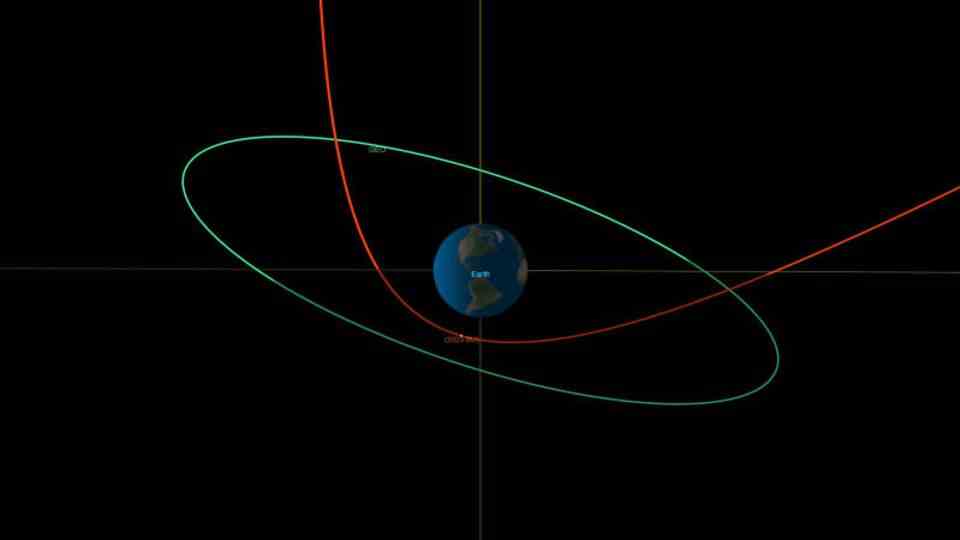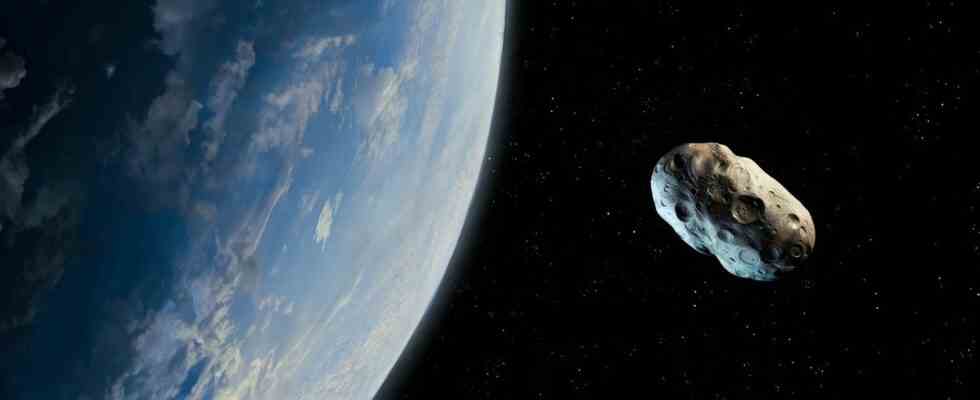space projectile
Just off the mark is also over: the asteroid will only miss the earth by 3600 kilometers
This picture is not real, but it could look something like this when the celestial body called “2023 BU” raced past the southern tip of South America at 1:27 a.m. German time early on Friday.
© Nazarii Neshcherenskyi / Getty Images
It’s going to be tight: According to Nasa, a delivery truck-sized asteroid will pass our planet on Friday night. The space projectile should rush past the earth at an altitude of only 3600 kilometers.
An asteroid passes exceptionally close to Earth on Friday night. The celestial body called “2023 BU” reached the closest point of its orbit early Friday at 1:27 a.m. German time, as the US space agency Nasa announced. Then the asteroid, about the size of a delivery truck, rushes past the southern tip of South America at an altitude of only 3600 kilometers. According to Nasa, there is no risk of an impact. For comparison: Geostationary satellites are around 36,000 kilometers from Earth, the ISS space station around 400 kilometers.
Nasa engineering
The expensive look at the stars is worth it: 15 everyday technologies that would not exist without space travel
Asteroid would not pose a threat even on a collision course
Even if “2023 BU” was heading straight for Earth, it would largely burn up as a fireball when it entered the atmosphere, given its comparatively small diameter of 3.5 to 8.5 meters, according to NASA. In all likelihood, however, it will be one of the closest approaches to Earth that has ever been recorded, the statement said.

This orbital diagram shows the trajectory of “2023 BU” (in red) as it approaches Earth. The asteroid will pass about 10 times closer to Earth than the orbits of geosynchronous satellites, shown in the green line.
© NASA/JPL-Caltech/DPA
The amateur astronomer Gennady Borissow discovered the celestial body at the Margo Observatory in Crimea a few days ago. Borissov made a name for himself in 2019 when he used a homemade telescope to discover a comet crossing our solar system on its journey from deep space. Comet 2I/Borisov attracted worldwide interest among astronomers at the time, who confirmed its observations.
International observatories also immediately targeted Borisov’s most recent discovery in order to determine the orbit of “2023 BU” and thus possible risks for the earth. A threat from the asteroid could then be quickly ruled out, as Nasa scientist Davide Farnocchia explained.
Just in case: The Planetary Defense Coordination Office should save the earth in an emergency
Researchers have identified around 27,000 asteroids near Earth, of which around 10,000 are more than 140 meters in diameter. None are known to be able to crash directly into our planet in the foreseeable future.
But they do exist, the horror scenarios. The best-known example is certainly the chunk of space that hit what is now Mexico more than 66 million years ago, ending the age of the dinosaurs in one fell swoop. Scientists currently see no signs that such a “global killer” is racing towards our planet. But if you do, you want to be prepared.
That’s what the Planetary Defense Coordination Office, or PDCO for short, is for. The motto: “Hic servare diem”, “Here to save the day”, as it says on the logo. Read here how exactly the US authorities are supposed to prevent the end of the world.

